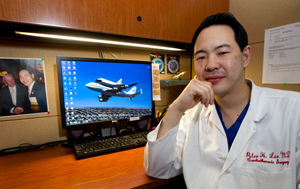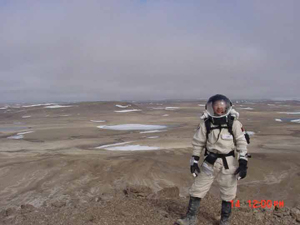January 28, 2013 - By Tracie White

Peter Lee will study the effects of weightlessness on the hearts of fruit flies sent to the International Space Station in December of this year.
Peter H.U. Lee, MD, is reaching for the stars.
The Stanford heart surgeon has combined his twin passions — medicine and outer space — in a joint proposal for an experiment on the effects of weightlessness on the hearts of fruit flies. Next December, a cohort of these tiny insects-turned-astronauts are scheduled to blast off from Cape Canaveral Air Force Station aboard a SpaceX Falcon 9 rocket. Their destination: The U.S. National Lab, on the International Space Station, in orbit roughly 240 miles above the Earth.
Apparently, space is rough on hearts, and researchers want to know more about the risks to astronauts, particularly those who are sent on long missions.
"We'll send up the flies for a month, then analyze them in a lab when they get back," said Lee, explaining that hundreds of live flies will be stored in food-equipped test tubes and packaged in a small storage box called a NanoLab for the flight. "We'll be looking at how well the flies' hearts squeeze and look after being in space — whether there are more arrhythmias or any changes in gene expression."
Lee and his collaborators at NASA Ames Research Center in Mountain View and the Sanford-Burnham Medical Research Institute in San Diego were one of eight teams to win a research competition in December sponsored by Space Florida. As a result, their experiment gets a free trip aboard a rocket.

Lee, an aficionado of outer space, applied last year to be an astronaut. Above, he joined a Mars simulation team about a decade ago for an expedition to an Arctic island that roughly approximates the Martian environment.
Lee was working in his cubicle at the Falk Building, in between heart/lung transplantation surgeries, surrounded by his space memorabilia — a photo of himself shaking hands with astronaut Neil Armstrong, a screensaver of the Space Shuttle Endeavour atop a 747 airliner — when he heard about the contest, and came up with the idea for the experiment.
"I was looking for something related to heart disease and heart function that could fit in the 10-by-10-by-10-centimeter cube that they provide for the experiment to sit in," Lee said.
The 40-year-old Stanford clinical instructor in cardiothoracic surgery has supplemented his extensive education with skills that could come in handy if he ever traveled into space himself: He has taken courses in space medicine and Russian — to communicate with cosmonauts aboard the space station — and earned a pilot's license.
As a graduate student at Brown University, he was principal investigator for an experiment that sent muscle tissue on a space shuttle mission to study muscle atrophy. About 10 years ago, he joined a Mars simulation team for a month-long expedition to an Arctic island that roughly approximates the Martian environment. And somewhere along the way he conducted CPR experiments on the aptly dubbed "vomit comet," a reduced gravity aircraft designed for training astronauts and conducting research.
With this bounty of experience, he had the confidence to start looking online for possible collaborators who could provide the skill sets necessary to conduct a heart experiment on fruit flies in space. He found researchers at NASA who had experience sending fruit fly experiments into space and, at Sanford-Burnham, others who had conducted heart experiments on fruit flies. Lee contacted both, and they bought in to the idea. Together they wrote up a proposal and won some room on the rocket for their fruit flies.

The fruit flies will spend a month aboard the International Space Station, in orbit roughly 240 miles above Earth.
Since then, they've also applied for a NASA grant to continue research on the effects of space on the Drosophila heart.
"Drosophila (fruit flies) work really well for space flight experiments," said Sharmila Bhattacharya, the principal investigator of the Biomodel Performance Lab at the NASA Ames Research Center. "You don't get a whole lot of 'space' for space experiments. You can't send very heavy or big things up. When you do science in space, you make do with as little resources as possible."
It's generally known that space flight causes multiple physiological changes in humans — in particular, muscle atrophy — but every system in the body is generally affected in a negative way, Lee said. Little is known about the effects on the heart.
Among astronauts, "there appears to be a higher rate of irregular heart rhythms, some decrease in the size or mass of the heart and a little bit of decrease in heart function after long space flights," Lee said. "It's not life threatening, but not a lot is known. Fruit fly research is beneficial because they have a lot of the same basic genes and molecular signal transduction mechanisms as humans."
Not surprisingly, Lee's childhood dream was to become an astronaut, and he's never quite let go of that dream.
"I applied last year to be an astronaut," he said, with a sheepish grin, adding that he was one of 6,100 applicants to the space medicine astronaut program. "I would have applied sooner, but I just became a U.S. citizen two years ago."
In any case, Lee has been busy. In addition to his surgical training, he's finishing up a PhD in pathobiology and has completed two master's degrees — one in space studies at the International Space University in France, the other in public health at Harvard. He loves his earthbound work as a surgeon, but he hasn't totally abandoned the hope of someday being a surgeon in space. Asked if he would like to accompany the fruit flies into space, he flashed a big smile.
"Oh my gosh, yes, I want to go with," he said.
About Stanford Medicine
Stanford Medicine is an integrated academic health system comprising the Stanford School of Medicine and adult and pediatric health care delivery systems. Together, they harness the full potential of biomedicine through collaborative research, education and clinical care for patients. For more information, please visit med.stanford.edu.